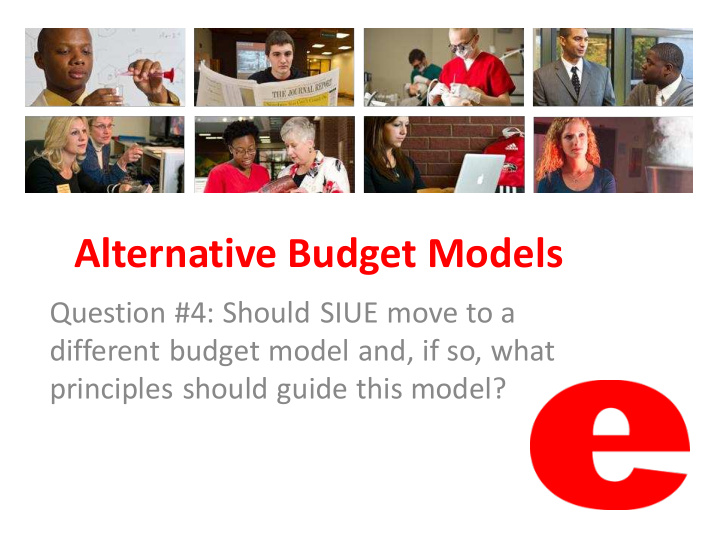



Alternative Budget Models Question #4: Should SIUE move to a different budget model and, if so, what principles should guide this model?
Our Budget SIUE Sources of Revenue FY 2015 $ Millions Private Grants/Contracts, $2.20, Purchases/Services, $33.80, 1% Tuition, $89.30, 33% 12% Federal Grants/Contracts & ICR, $35.40, 13% State Grants/Contracts, $1.90, 1% State Appropriations, $59.90, Student Fees, $28.80, 11% 22% Total Budget $271.2 million Housing, $19.90, 7%
State vs Non-State Revenue Non-State Revenue 45% State Revenue 55%
Breakdown of Tuition vs Appropriations State Appropriations, $59.90, Tuition, $89.30, 60% 40%
Characteristics of Budget Models: 1. Level of Decision Making 2. Transparency 3. Degree to Which Budget is Incentive-Driven 4. Cost vs Revenue Driven 5. Flexibility
Basic Continuum of Budget Models Formula- Performance- Responsibility Zero-Based Incremental Based Based Centered Budgeting Budgeting Budgeting Budgeting Budgeting
Short Description of Each Model • Zero-Based Budgeting: Each year a unit’s budget begins at a zero baseline. • Formula- Based Budgeting: Each year a unit’s budget is determined by a specific formula. May be based on enrollment, revenue, costs, etc. • Incremental Budgeting: Each year a unit’s budget starts with the previous year’s budget as a baseline.
Short Description of Each Model Performance-Based Budgeting: Each year a unit’s budget is determined based on certain performance measures. Responsibility Centered Budgeting: Each unit is treated as a separate entity. The unit’s budget is based on revenue generated by the unit.
What Type of Model Does SIUE Currently Use? • Our current budget model is a version of incremental budgeting • Each unit’s budget this year is basically their budget from last year plus or minus incremental revenue • It is in the middle of the budget continuum
How do Alternative Models Compare? Level of Decision Making: • Zero-Based: Central • Formula-Based: Central • Incremental: Central • Performance-Based: Unit level • Responsibility Centered: Unit level
How do Alternative Models Compare? Level of Transparency (to all units): • Zero-Based: High • Formula-Based: High • Incremental: Medium • Performance-Based: High • Responsibility Centered: Low
How do Alternative Models Compare? Level of Incentives: • Zero-Based: Low • Formula-Based: High • Incremental: Low • Performance-Based: High • Responsibility Centered: High
How do Alternative Models Compare? Cost or Revenue Based: • Zero-Based: Cost • Formula-Based: Either • Incremental: Cost • Performance-Based: Revenue • Responsibility Centered: Revenue
How do Alternative Models Compare? Flexibility: • Zero-Based: Medium • Formula-Based: Low • Incremental: Medium • Performance-Based: Low • Responsibility Centered: High
Budget Models Summary Zero-Based: Formula-Based: Incremental: Performance-Based: Responsibility Centered: Centralized Centralized Centralized Unit Level Unit Level Transparent Transparent Some Transparency Transparent Not Transparent Little Incentive High Incentive Little Incentive High Incentive High Incentive Cost-Based Cost- or Revenue-Based Cost-Based Revenue-Based Revenue-Based Some Flexibility Little Flexibility Some Flexibility Little Flexibility High Flexibility
Discussion Questions • What are the biggest problems associated with SIUE’s current approach to budgeting? • What attributes of the budget alternatives that were described do you particularly like or don’t like? • If we are to change our approach to budgeting, what principles need to be considered as the new budget model is designed? • We’ll begin the reporting -back process in about 20 minutes
Recommend
More recommend